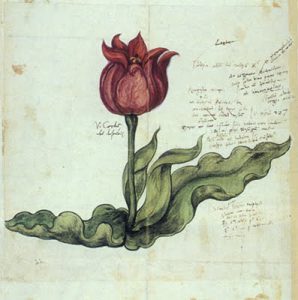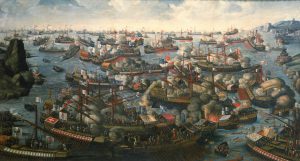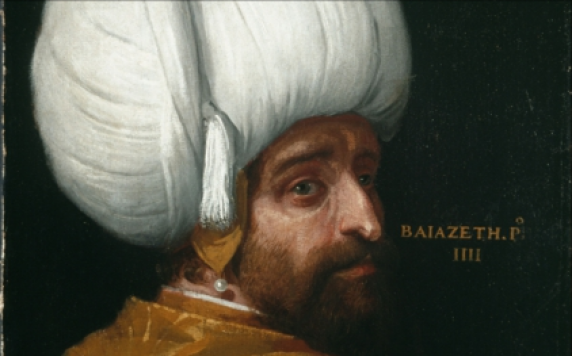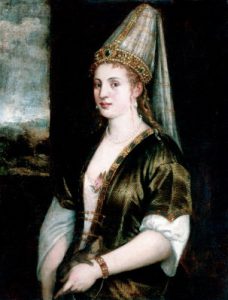Harems, sultans, concubines and images of Turkish baths are the first things that come in mind when the Ottoman World is mentioned. The European perception of the Ottomans and the Orient was mostly limited to these aspects, especially during the 18th and 19th centuries. Through writings of travelers and paintings of artists, the oriental cultural influences were substantial and can be abundantly found in literature, dance, theater, fashion. : However, it is necessary to put these cultural exchanges in a broader temporal and geopolitical context. This is the theme of the exhibition “The Sultan’s World: The Ottoman Orient in Renaissance Art”, currently on display at Bozar in Brussels. Beautiful paintings and astonishing objects are presented, giving us the opportunity to approach the political, diplomatic and cultural relations between Europe and the Ottoman world from a different perspective.
Among these objects I would like to point out three that I consider fascinating. The first one is a Titian portrait of Roxelana, wife of Suleiman the Magnificent. She is depicted in a beautiful velvet dress, with her red hair decorated with precious stones, her eyes facing directly the spectator. Contrary to many later representations of women in an Oriental context, and although she is part of the Sultan’s harem, she is standing there before us, looking at us without any sensual disposition. Her look illustrates her strong character, her noble origins and her authority. A captivating and intriguing painting, just like the woman it was meant to represent.
 The aquarelle of Conrad Gesner entitled “Tulipe” is the second item from the exhibition that caught my eye. A very simple and elegant drawing of a flower that in fact reveals its origins! Perhaps not widely known in the northern part of Europe, this wild flower was first noticed and admired by Ogier Ghislain de Busbecq, when he visited Constantinople as an imperial ambassador of the Holy Roman Empire. It is not clear how and when finally tulips were introduced to the rest of Europe, but that certainly happened thanks to the cultural exchanges between Europeans and Turks.
The aquarelle of Conrad Gesner entitled “Tulipe” is the second item from the exhibition that caught my eye. A very simple and elegant drawing of a flower that in fact reveals its origins! Perhaps not widely known in the northern part of Europe, this wild flower was first noticed and admired by Ogier Ghislain de Busbecq, when he visited Constantinople as an imperial ambassador of the Holy Roman Empire. It is not clear how and when finally tulips were introduced to the rest of Europe, but that certainly happened thanks to the cultural exchanges between Europeans and Turks.
 The last painting I would like to mention is actually the one appearing first in the exhibition. “La bataille de Lépante” is an impressive painting of an anonymous artist dated to the end of 16th century. It depicts the homonymous battle of 1571, which took place in the gulf of Patras, between the fleet of the Holy League and the fleet of the Ottomans. The battle ended with the victory of the Holly League, but also with a significant number of casualties for both sides. The painting represents a moment of the battle. The horizon is overcrowded with ships in a chaotic context, and in a closer look small boats and bodies of soldiers can be seen floating in between. The weapons, the fire and the smoke accentuate the agony of the moment and of course the flags on the ships represent the two parties in the battle and each one with its holy cause.
The last painting I would like to mention is actually the one appearing first in the exhibition. “La bataille de Lépante” is an impressive painting of an anonymous artist dated to the end of 16th century. It depicts the homonymous battle of 1571, which took place in the gulf of Patras, between the fleet of the Holy League and the fleet of the Ottomans. The battle ended with the victory of the Holly League, but also with a significant number of casualties for both sides. The painting represents a moment of the battle. The horizon is overcrowded with ships in a chaotic context, and in a closer look small boats and bodies of soldiers can be seen floating in between. The weapons, the fire and the smoke accentuate the agony of the moment and of course the flags on the ships represent the two parties in the battle and each one with its holy cause.
“The Sultan’s World: The Ottoman Orient in Renaissance Art” is a beautiful exhibition that represents the military but also the cultural power of the Ottoman Empire, and the ways in which Europe approached and was influenced by it.
“The Sultan’s World: The Ottoman Orient in Renaissance Art”, Exhibition at Bozar, Brussels, 27 February–31 May 2015
Click here for more details on the exhibition and here for information on the broader international project entitled “Ottomans & Europeans”, in the context of which this exhibition is organized.



